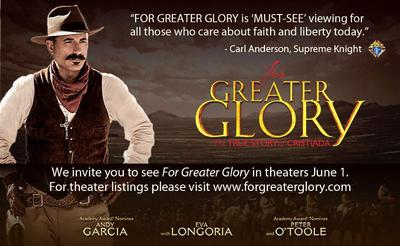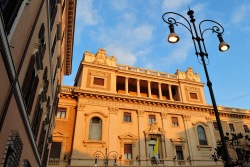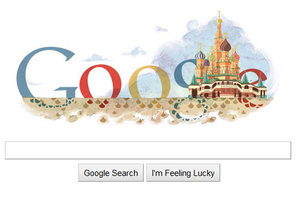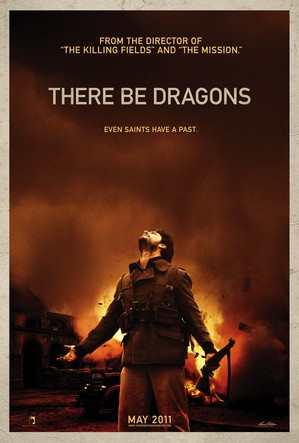Marc Barnes publishes his essays on his blog, Bad Catholic on Patheos. A recent installment, Humans Are Useless, is a beautiful piece on humanity, God, human relationships, sex, art and Love. My friend Tacy give me the tip to read this essay. It is rewarding. The essay is an excellent piece for faith formation.
Tag: art
For Greater Glory
We invite you to see For Greater Glory in theaters June 1st.
For theater listings please visit www.forgreaterglory.com today!
“Building a New World”: exploring human and spiritual issues through film
“Building a New World” is new initiative Interdisciplinary Centre for Social Communications of the Pontifical Gregorian University (Rome, Italy) beginning today, Friday, 2 March.
This project is focused on film and the power film has in our lives. The premise is: a good film liberates, forms and calls us to a new way of seeing and engaging in reality. Therefore, the good people at the Gregorian are exploring how a good movie or documentary can invite people to greatness through the imagination and research how a poorly written movie with mediocre images can severely handicap one’s openness to the true, the beautiful and the good. Just think of the good Father Robert Barron’s “Catholicism” project is doing for those learning the Catholic faith for the first time or those renewing their faith; or how damaging “The Deputy” was to to the person of Pope Pius XII and the rest of the Church.
Jesuit Father Lloyd Baugh, a professor of film, told Vatican Radio that the initiative honors the 30th anniversary of the University’s Center for Interdisciplinary Study. It is popular these days to get at human, theological and philosphical issues by the use of film. Friends of mine do it regularly in the schools in which they instruct young minds: Benedictine Father Bede Price teaches a theology and film course at his abbey’s Priory School (St Louis, MO) and Jesuit Father Edward Oakes does so at Mundelein Seminary (outside Chicago, IL). Father Baugh he teaches theology using film as the text for class: Christology through the “Jesus films,” moral issues through the “The Decalogue” of Kieslowski, interreligious dialogue through a whole series of films from different religious traditions and so on.
The current cycle of films starting today will be inaugurated by the Gregorian University Rector Jesuit Father Dumortier, Archbishop Claudio Celli, President of the Pontifical Council for Social Communications, of Jesuit Father Savarimuthu, director of the Centre for Interdisciplinary Studies at the Gregorian University, and Father Baugh.
The first film is “Welcome.” which focuses on a young Kurdish boy who attempts to illegally enter England, and in doing so encounters other people changing their vision of the world, and ultimately their lives. “Welcome” is a award 2009 winning film directed by Philippe Loiret.
Other films include
March 23: “Water” (2005 Deepa Mehta film) focuses on Asia and on “the right to Freedom” drawing attention to the tragic reality of millions of young girls in India who are promised in marriage to elderly men and widowed shortly thereafter, leaving them destitute for the rest of their lives.
April 20: “La Zona” (2007 Roderigo Pla film) dedicated to the “Americas” and to the “right to Justice”, highlighting the persistent and ever-growing disparity between rich and poor particualrly in Latin America.
May 4: “Son of Man” (2006 Mark Dornford May) looks at the plight of the African continent and its “right to Hope”. May directs a narrative of the Gospel and situating the contemporaneous of the biblical reality of a township outside of Cape Town. The desire for peace is continuously punctuated by violence. It is a look at how Jesus would respond to the human reality before his eyes and what he does to change people’s hearts.
Screenings are free and everyone is welcome. For more information visit: www.unigre.it
Vespers for All Saints and a lecture “Art, Beauty and the Sacred” in NYC
The Catholic Artists Society is hosting a lecture on October 31st at 6:30pm titled “Art, Beauty and the Sacred” given by Oratorian Father Uwe Michael Lang. The evening will include the celebration of First Vespers of All Saints in the Church of Saint Vincent Ferrer (NYC). The flyer can be viewed here: Catholic Artists Society All Saints and lecture.pdf
Vespers
We will celebrate the ancient and beautiful liturgy of Solemn First Vespers for All Saints, officiated by our special guest, Father Uwe Michael Lang, C.O. Father Bruno Shah, O.P. from Saint Vincent Ferrer, and Father Michael Barone from the archdiocese of Newark, will assist in the liturgical celebration. Gregorian chant and polyphonic settings will be provided by a professional choir led by David J. Hughes, Organist & Choirmaster at Saint Mary’s Church, Norwalk, CT.
Continue reading Vespers for All Saints and a lecture “Art, Beauty and the Sacred” in NYC
Artistic expression is part of that “way of beauty” that leads to God
Pope Benedict gave the following teaching on beauty –a subject near to his heart– on August 31. Some of the paragraphs are here (the entire address is here). Isn’t what the Pope says true???? The beautiful expressed in food, music, art, architecture, the human body, the poerty and friendship is the extroversion of the Holy Spirit.
Today, I would like to consider briefly one of these channels that can lead us to God and also be helpful in our encounter with Him: It is the way of artistic expression, part of that “via pulchritudinis” — “way of beauty” — which I have spoken about on many occasions, and which modern man should recover in its most profound meaning.
Perhaps it has happened to you at one time or another — before a sculpture, a painting, a few verses of poetry or a piece of music — to have experienced deep emotion, a sense of joy, to have perceived clearly, that is, that before you there stood not only matter — a piece of marble or bronze, a painted canvas, an ensemble of letters or a combination of sounds — but something far greater, something that “speaks,” something capable of touching the heart, of communicating a message, of elevating the soul.
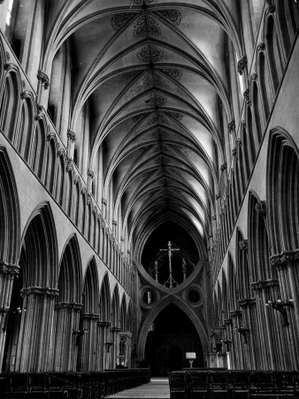 A work of art is the fruit of the creative capacity of the human person who stands in wonder before the visible reality, who seeks to discover the depths of its meaning and to communicate it through the language of forms, colors and sounds. Art is capable of expressing, and of making visible, man’s need to go beyond what he sees; it reveals his thirst and his search for the infinite. Indeed, it is like a door opened to the infinite, [opened] to a beauty and a truth beyond the every day. And a work of art can open the eyes of the mind and heart, urging us upward.
A work of art is the fruit of the creative capacity of the human person who stands in wonder before the visible reality, who seeks to discover the depths of its meaning and to communicate it through the language of forms, colors and sounds. Art is capable of expressing, and of making visible, man’s need to go beyond what he sees; it reveals his thirst and his search for the infinite. Indeed, it is like a door opened to the infinite, [opened] to a beauty and a truth beyond the every day. And a work of art can open the eyes of the mind and heart, urging us upward.
Continue reading Artistic expression is part of that “way of beauty” that leads to God
St Basil’s Cathedral at 450
A Benedictine’s art collection
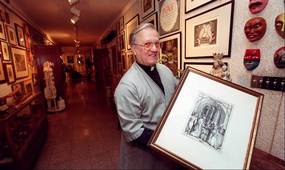 Benedictine culture is very interesting. I find this to be true for 2 reasons: after 1500 years of Benedictine monasticism a refined style of humanity and relationship with God is constitutive and monasteries have interesting people as monks and nuns. The famous Rule of Saint Benedict encourages the monk to praise and worship God through a proper ordering of life and interest. Few Benedictines I know are not proficient in works of culture (in the true meaning of the word) like music, vestment making, bee keeping, keeping the library, preparing good lessons for the classroom, cooking, music writing, preaching, study and the like.
Benedictine culture is very interesting. I find this to be true for 2 reasons: after 1500 years of Benedictine monasticism a refined style of humanity and relationship with God is constitutive and monasteries have interesting people as monks and nuns. The famous Rule of Saint Benedict encourages the monk to praise and worship God through a proper ordering of life and interest. Few Benedictines I know are not proficient in works of culture (in the true meaning of the word) like music, vestment making, bee keeping, keeping the library, preparing good lessons for the classroom, cooking, music writing, preaching, study and the like.
Paul Haring: opening the shutter to view Christ’s vicar
Paul Haring, a photojournalist who works for Catholic News Service in Rome talks about his vocation in following Pope Benedict to record for us “the moment” with the Vicar of Christ. As Paul notes, it is a singular act of Providence to be see life through an new lens, especially when pointing that lens at the Supreme Pontiff.
Art is not merely an option for the Christian
Our Lord ascended to Heaven so that the Holy Spirit
might come at Pentecost and fill the Church with His truth. The greatest art
expresses that truth and is far superior to vain “self-expression.”
John Keats said “Beauty is truth, truth beauty,” but T.S. Eliot
rightly thought that the expression was meaningless sentimentality. The
craftsman ignorant of the Creator becomes a vain aesthete expressing nothing
more than the ego. While truth is beautiful, beauty is not truth itself but
expresses that truth. In the classical tradition, beauty consists in
proportion, integrity and clarity: it is harmonious, suited to its purpose, and
intelligible. This is sublimely seen in Christ Himself, Who incarnated this
beauty as the Way (guiding to a harmony of virtue) and the Truth (revealing
God) and the Life (enlightening with creative love). St. Macarius, an Egyptian
monk of the fourth century said, “The soul which has been fully illumined
by the unspeakable beauty of the glory shining on the countenance of Christ overflows
with the Holy Spirit . . . it is all eye, all light, all countenance.”
is not merely an option for the Christian. Thus, the wisdom of Lorenzo in The
Merchant of Venice: “The man that hath no music in himself, Nor is not
mov’d with concord of sweet sounds, Is fit for treasons, stratagems, and spoils
. . .” The most sublime art is the Eucharist, in which we “take part
in a foretaste of that heavenly liturgy which is celebrated in the holy city of
Jerusalem toward which we journey as pilgrims . . .” (Vatican II, SC 8).
‘There Be Dragons’ — Even Saints Have A Past
Continue reading ‘There Be Dragons’ — Even Saints Have A Past
